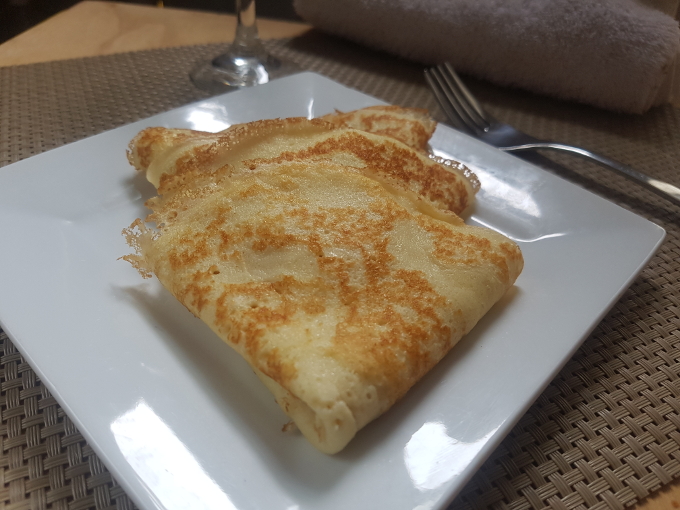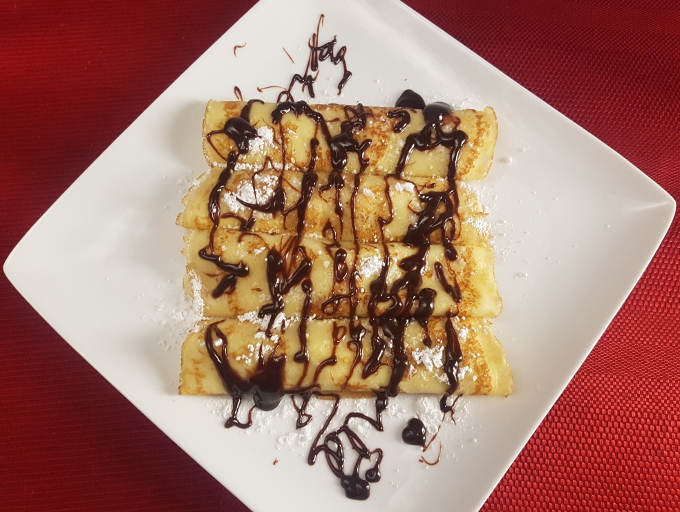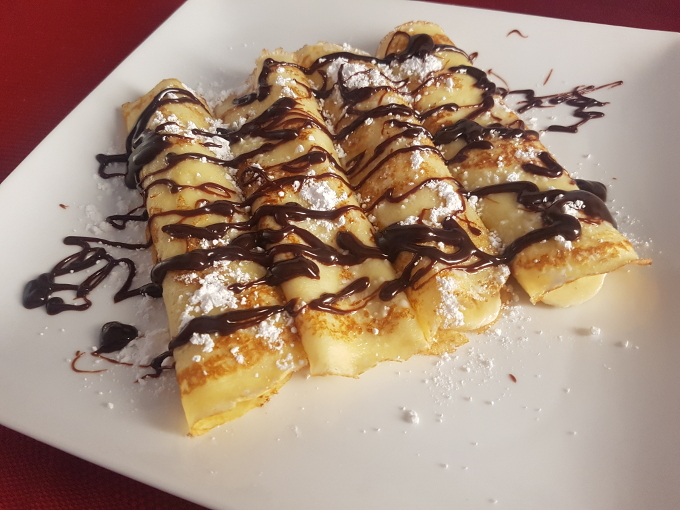
What can I say about these famous French pancakes? Well it turns out, probably a lot. My interest in the French culture and culinary arts has grown considerably over the last couple years, so why not spend some time discussing these delicious breakfast treats with everyone else?
Before we get into it though, let’s get something out of the way. I think there’s a bit of a stigma about crêpes. They seem to have a reputation for being temperamental; demanding precise heat, a specialized pan, properly mixed batter, and the perfect handling from the chef while cooking.
I think this is the mindset of old-school French chefs. So let’s not get too worked up about the details and simply enjoy the process.
So what is a crêpe?
Well, a crêpe is nothing more than a thin pancake, cooked briefly on each side and typically wrapped around a sweet or savory filling.
Most people I’m guessing, are going to be more familiar with the sweet crêpes, but I want everyone to be aware that there are other varieties as well. Below, I’ve linked a section from the Wikipedia entry on crêpes:
Crêpes are especially popular throughout France. The common ingredients include flour, eggs, milk, butter, and a pinch of salt. Crêpes are usually of two types: sweet crêpes (crêpes sucrées) made with wheat flour and slightly sweetened; and savoury galettes (crêpes salées) made with buckwheat flour and unsweetened. The name “galette” came from the French word galet (“pebble”) since the first gallettes were made on a large pebble heated in a fire. Batter made from buckwheat flour is gluten-free, which makes it possible for people who have a gluten allergy or intolerance to eat this type of crêpe. Mille crêpes is a French cake made of many crêpe layers. The word mille means “a thousand”, implying the many layers of crêpe. Another standard French and Belgian crêpe is the crêpe Suzette, a crêpe with lightly grated orange peel and liqueur (usually Grand Marnier) which is subsequently lit upon presentation.
– Wikipedia

For the most part though, many of the recipes you’ll find are going to be quite similar. Some variations might sweeten the batter with a little sugar, or even spike it with something such as brandy. In fact, the only substantial difference you’re probably going to come across is that some recipes call for letting the batter rest for 1 to 2 hours after mixing.
Here’s the reasoning behind that, so you can then decide for yourself if you want to do this.
First, it is thought that by letting the batter rest, the starch granules in the flour can more fully hydrate. This supposedly produces a more tender crêpe.
And second, by allowing a rest time, any extra air which happened to get incorporated into the batter during mixing has time to dissipate, making the crêpes as thin as possible.
But the basics are always the same: flour and milk are blended or whisked with eggs, salt, and melted butter to create a light and creamy batter. The batter is then thinly spread out on the skillet. It’s cooked just until the edges become golden before being carefully flipped over to brown lightly on the other side.
Due to the high ratio of liquid to dry ingredients in the crêpe batter, the type of flour you choose won’t matter too much. Basically, the gluten development (the proteins that give baked goods their chewiness) becomes too diluted. I know the article above mentions some crêpes being made with buckwheat flour, but for the sake of simplicity I’m going to stick with regular wheat flour.
If you have lower protein cake flour, or higher protein bread flour feel free to use that. But plain all-purpose flour works just fine.

Crêpes stuffed with sliced bananas and topped with powdered sugar and hot fudge!
Now for a few pieces of advice if you find that your crêpes aren’t coming out quite right. I’m basing the following information on using an 8 – 10 inch skillet. It needs to be large enough to let the batter properly spread out.
To begin with, the heat of the pan plays an important role in the thickness and overall quality of your crêpe.
If the pan is too hot, the batter will begin to set before it has time to evenly coat the surface. This will cause the crêpe to become thick and spongy in some places while leaving holes in other places. An ideal crêpe should have a uniform thinness throughout.
If the pan is not heated sufficiently, the crêpe will lack strength and become pale and too flimsy to flip without running the risk of tearing.
To avoid this, try heating the pan somewhere between medium and medium-low heat for 8 – 10 minutes. I would like to be more specific but everyone’s stove top heats differently so you will need to find the “sweet spot” on your particular stove. This should help distribute the heat evenly throughout the pan and keep it from becoming too hot.
Also, since the crêpes are going to be much thinner than pancakes, don’t overdo the amount of batter you put in the pan. Somewhere between 1/4 and 1/3 of a cup at a time should work fine. Once the batter is in the pan, slowly begin to tilt the pan in a circular fashion, allowing the batter to seep out towards the edges of the pan. If it’s not quite spreading out like you want, try giving it a gentle shake as you tilt the pan.
You’ll want to cook the crêpe for about 30 – 45 seconds on the first side. You’re looking for the edges to become dry and lose their shine (some would say, “appear matte”). After you’ve cooked a few, you’ll start to get a feel for when it’s ready to be flipped.
Which leads us to what some will find to be the trickiest part of the whole thing. When flipping the crêpe, your goal is twofold; avoid tearing it and avoid burning your fingers. I recommend using a rubber spatula to loosen the crêpe and then gently lift up the edge until it’s high enough from the surface of the pan that you can grasp it with your fingers and nimbly flip it over so it can finish cooking for roughly 20 – 25 more seconds.
Remove the crêpe from the heat and transfer either directly to a plate, or onto a wire rack to allow any excess steam to disappear so they won’t stick to each other.
Now, it’s really personal preference what you put in the crêpe. Ideas could include whipped cream, powdered sugar, chocolate, caramel, orange or lemon zest, honey, strawberries, blackberries, sliced bananas, toasted almonds or pecans and many, many other things as well.
So don’t let any supposed difficulty stand in your way of trying your hand at cooking these delightful pancakes. All you need is your normal non-stick frying pan, a spatula and a little time. And the result is well worth the minimal effort required.

Crêpes
By: Some French Cooks
Serves: 2 -4
Ingredients:
- Vegetable oil or non-stick cooking spray
- 1 cup all-purpose flour
- 1 tablespoon sugar
- 1/4 teaspoon salt
- 1 1/2 cups whole milk (you can substitute 1% or 2% for whole, making the crêpes slightly runnier)
- 3 large eggs
- 2 tablespoons butter (melted and preferably unsalted)
Directions:
- If you want to do things the “proper” way, whisk flour, sugar and salt together in a medium bowl. Melt the 2 tablespoons of butter in a small pan over low heat. In a different bowl, whisk eggs and milk together. Now pour half of the milk and egg mixture into the dry ingredients and whisk until smooth. Add melted butter and whisk again. Finally add the remaining milk and egg mixture and whisk until everything is smooth.
- Alternately, you can simply melt the butter and then add it to the flour, sugar, salt, milk and eggs in one bowl then whisk until smooth.
- Cover bowl with towel and let sit for 1 – 2 hours (optional)
- Preheat skillet over medium to medium-low heat.
- You can either use a little vegetable oil or just go with non-stick cooking spray like I do.
- Using a 1/4 or 1/3 cup scoop crêpe mixture from bowl and pour it into the middle of the heated pan.
- Slowly swivel the pan in a circular motion letting the batter become thinner as it rolls to the edges
- When the edges of the crêpe become dull or lacy (30 – 45 seconds) carefully lift an edge of the crêpe with a rubber spatula, grasp a portion with your fingers and quickly flip the whole thing. If it isn’t cooked quite enough it will want to tear apart on you. If this happens, wait another 5 – 10 seconds and try again.
- Once flipped, allow the crêpe to cook for roughly 15 – 20 more seconds. It should be golden brown across various places but not black.
- Transfer from pan and stuff with your choice of fillings, then enjoy.


Post a comment